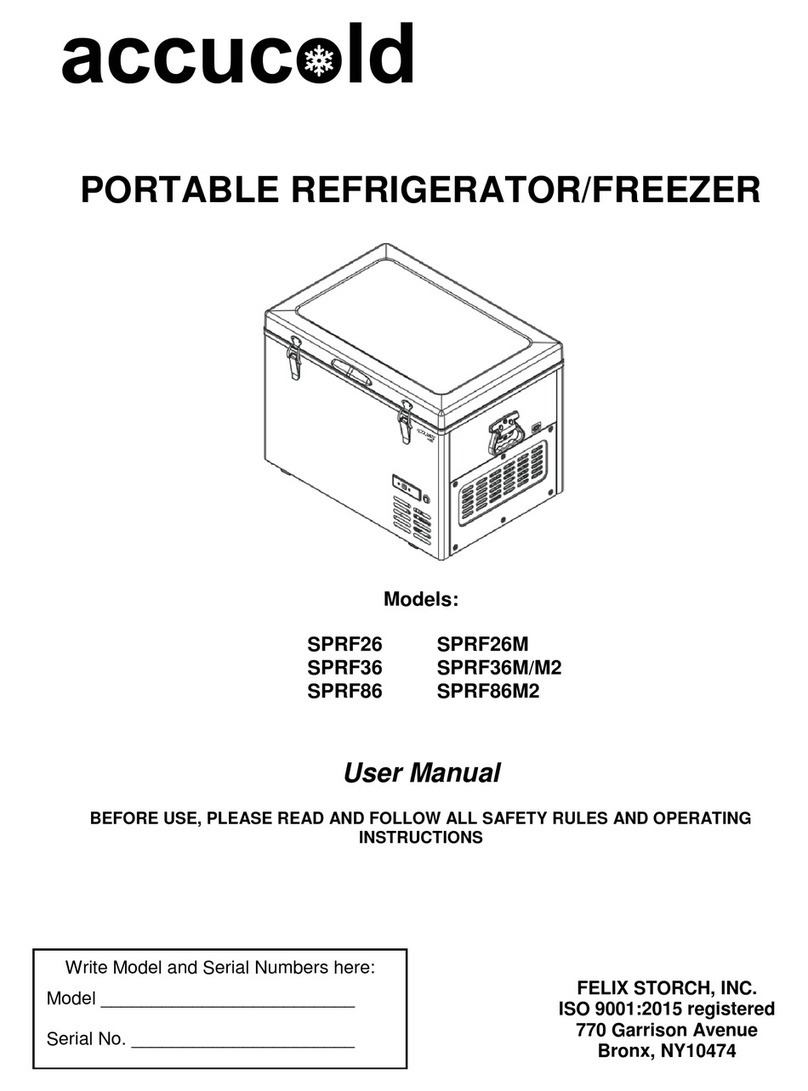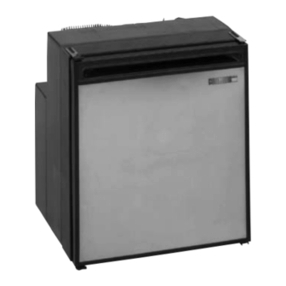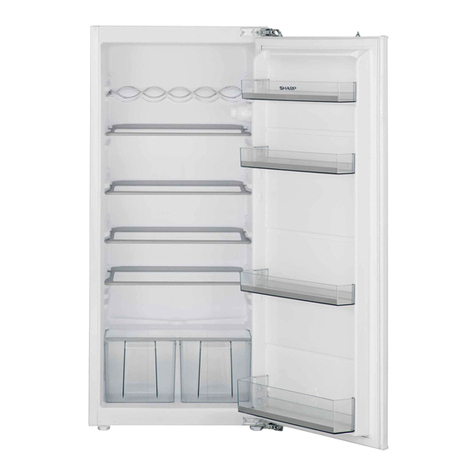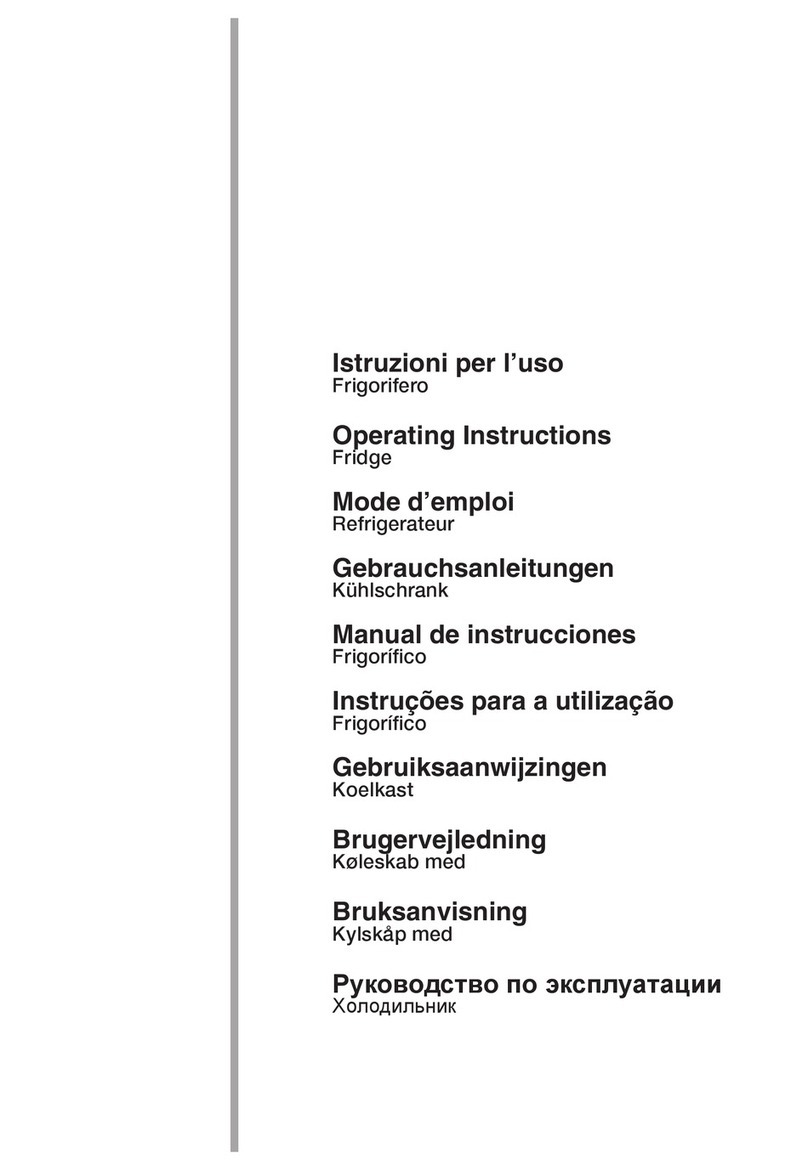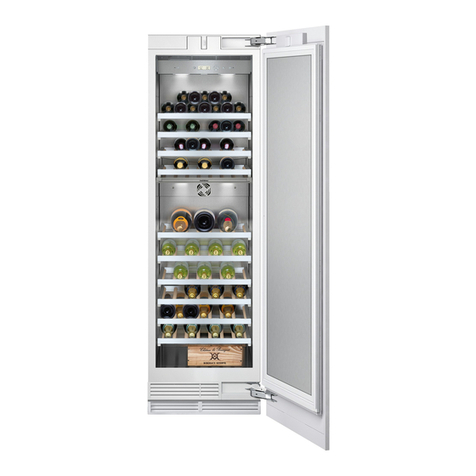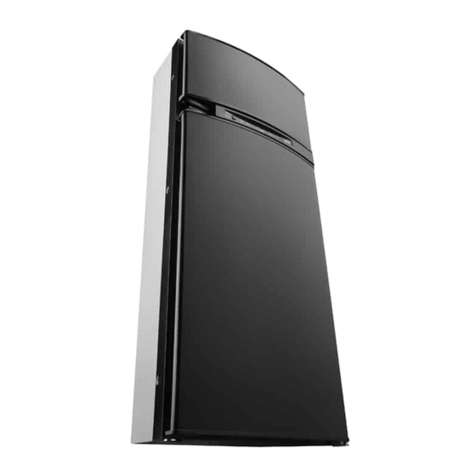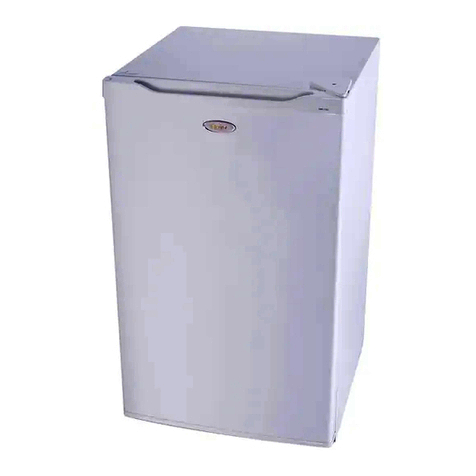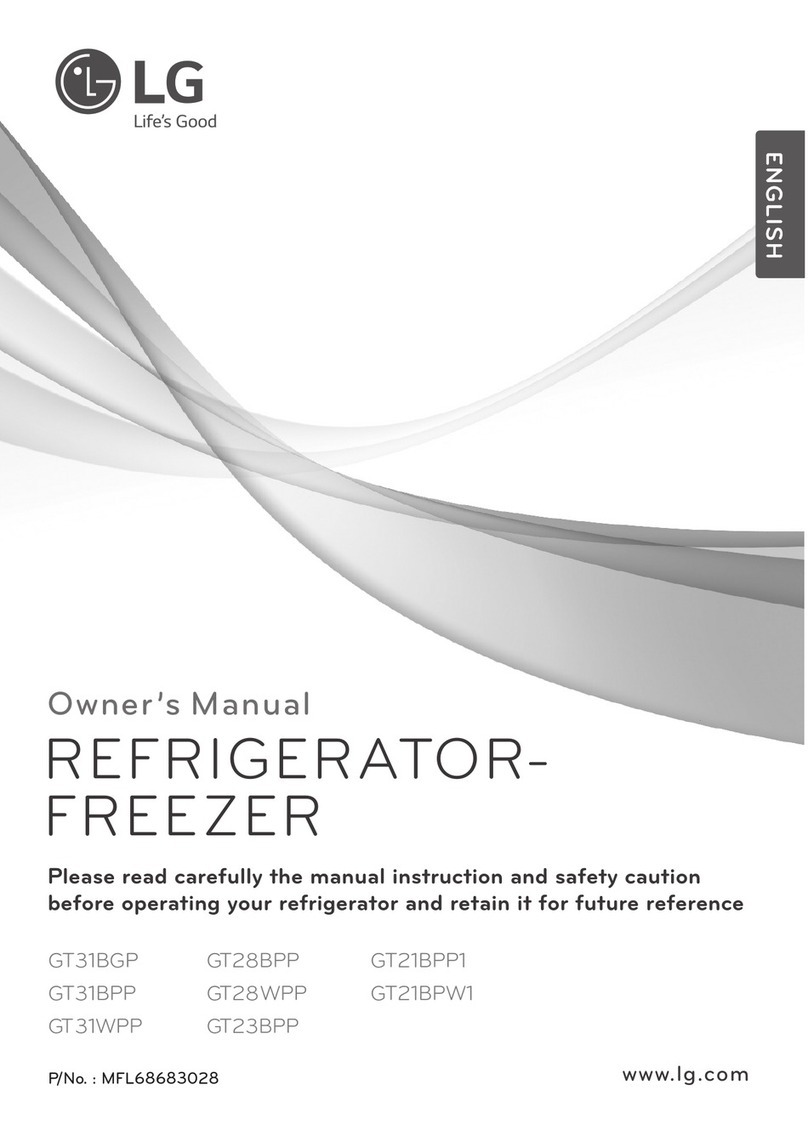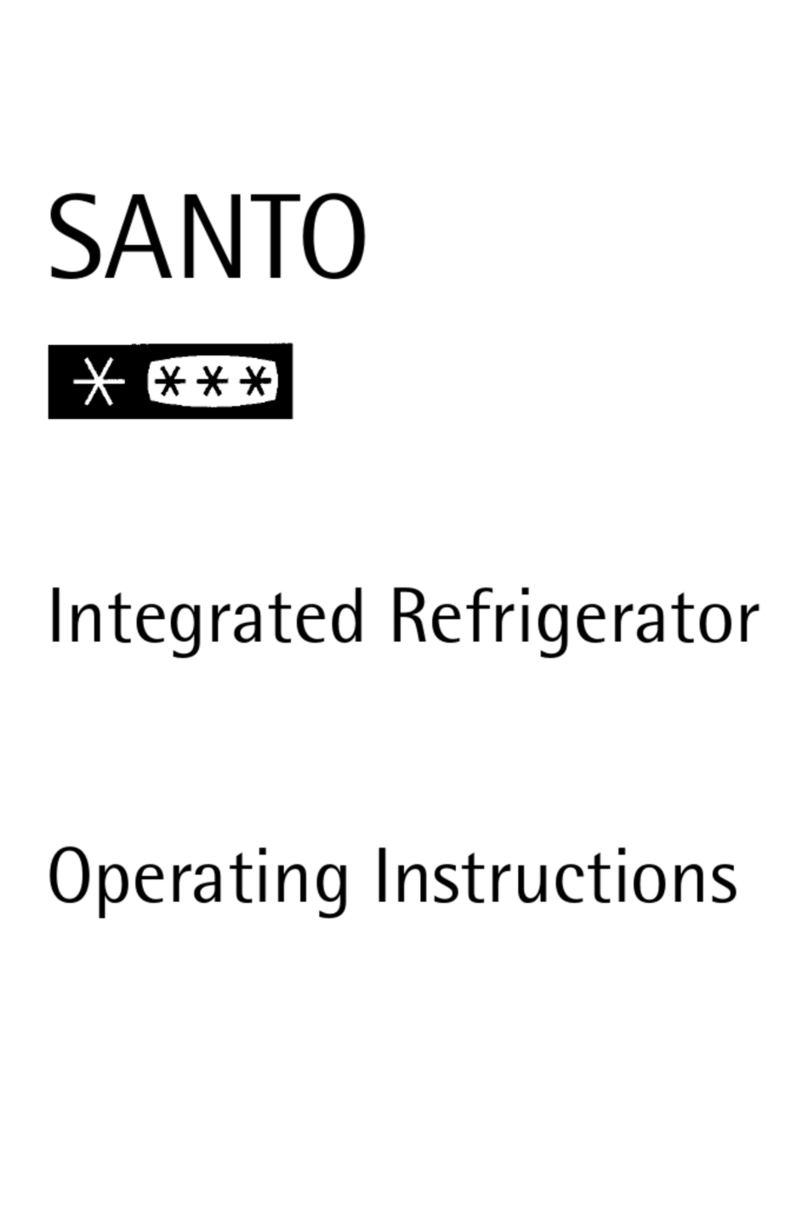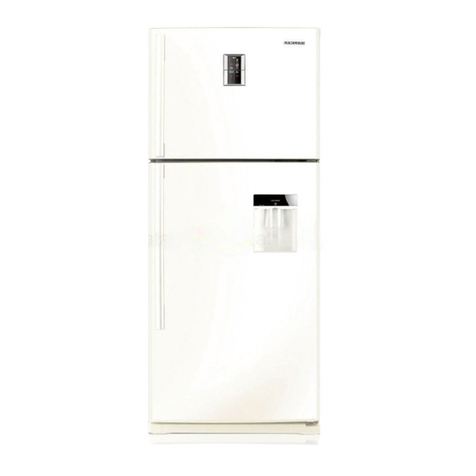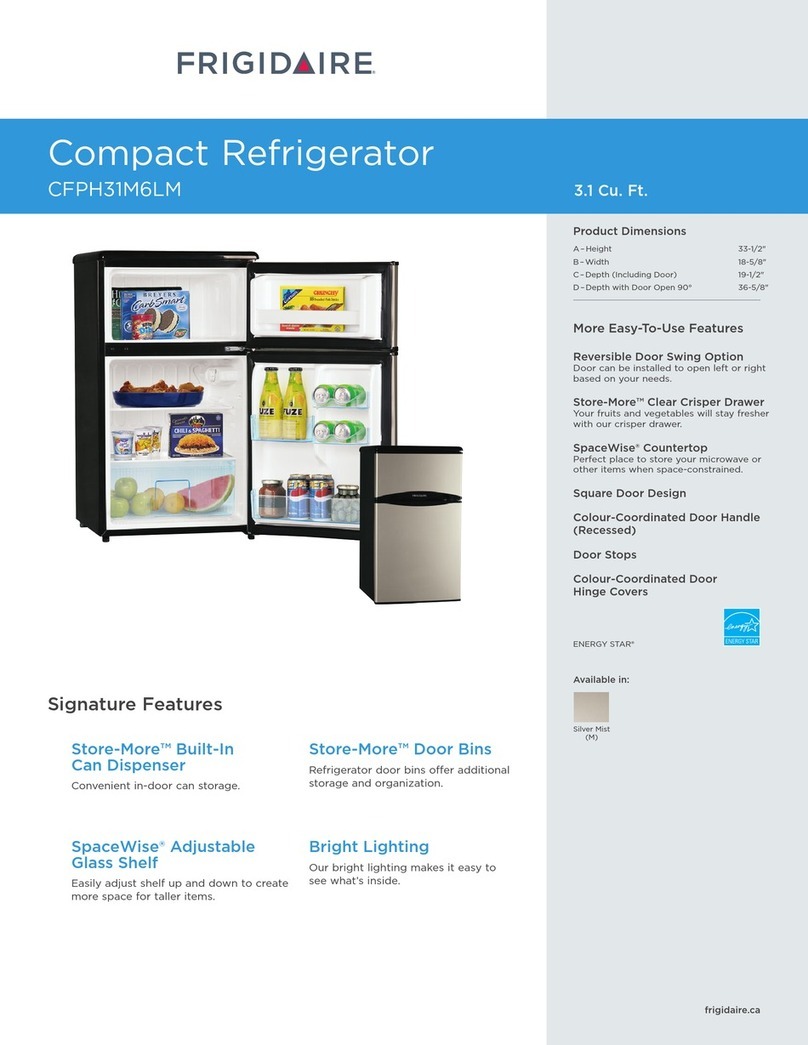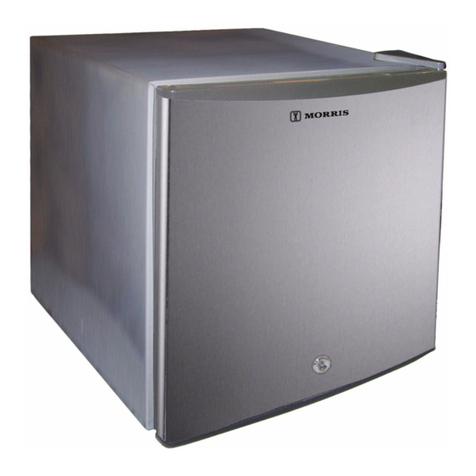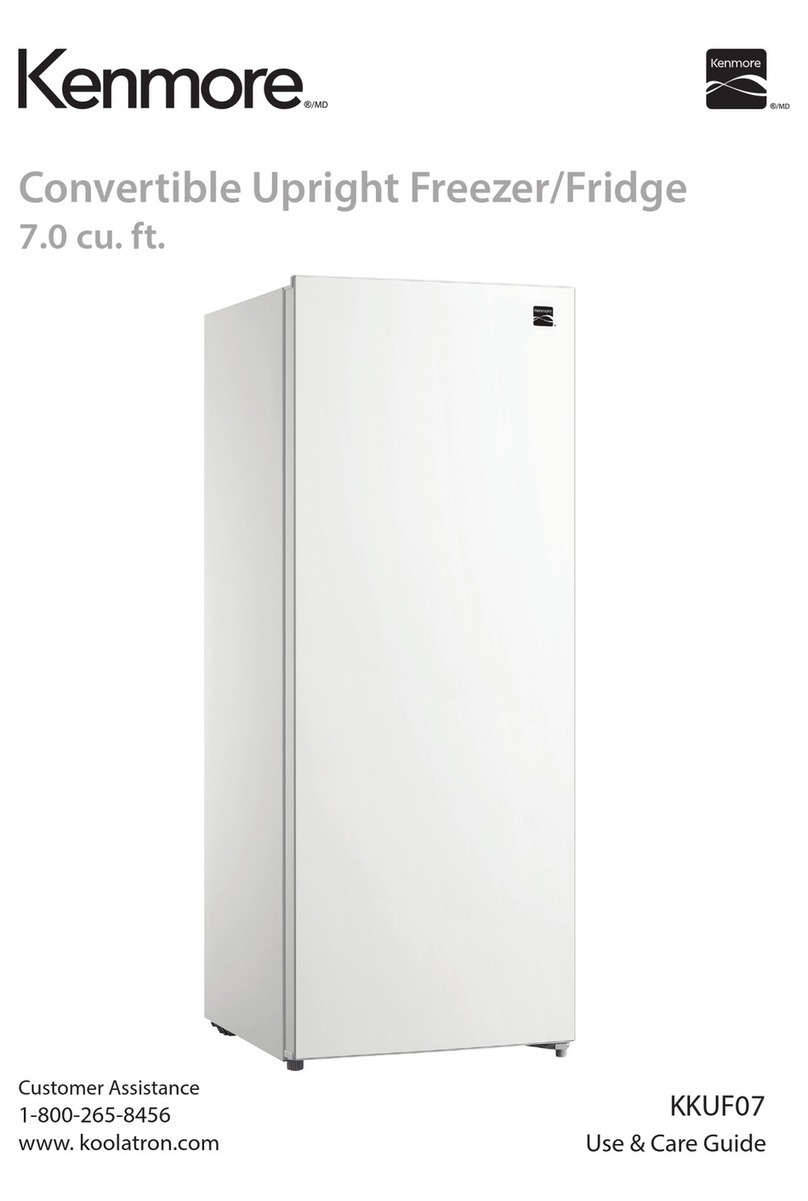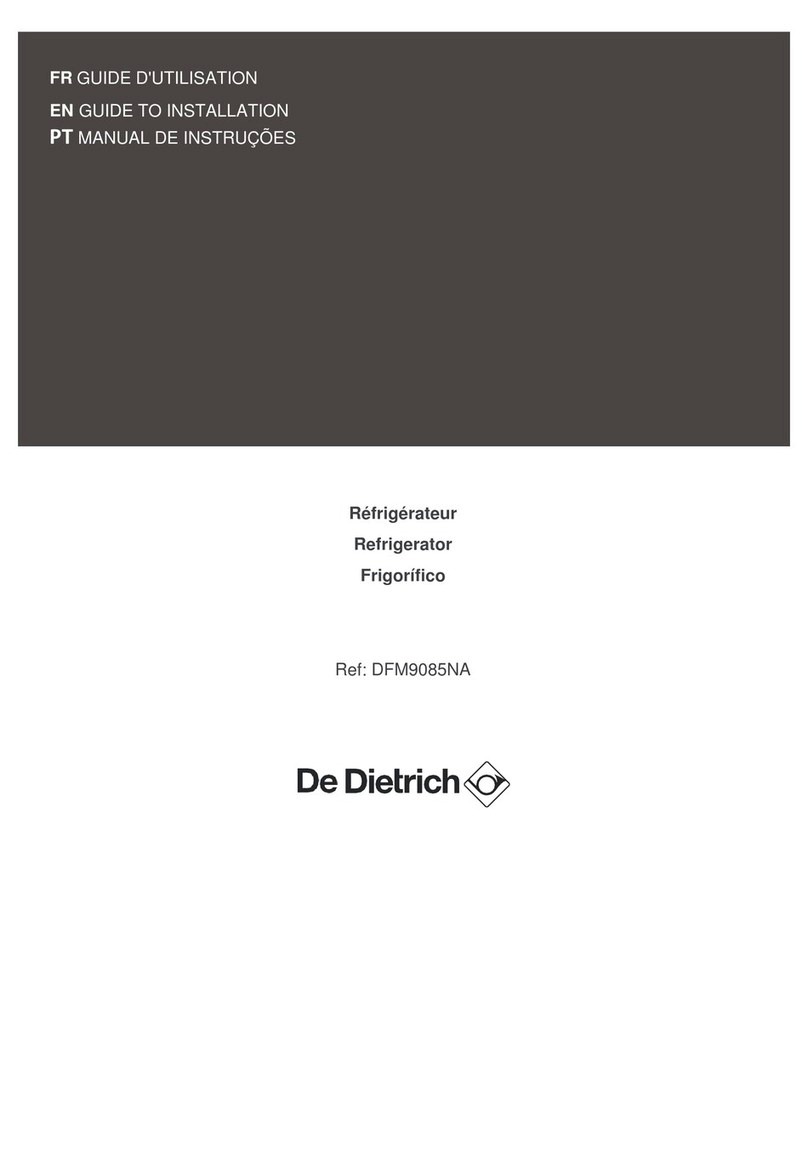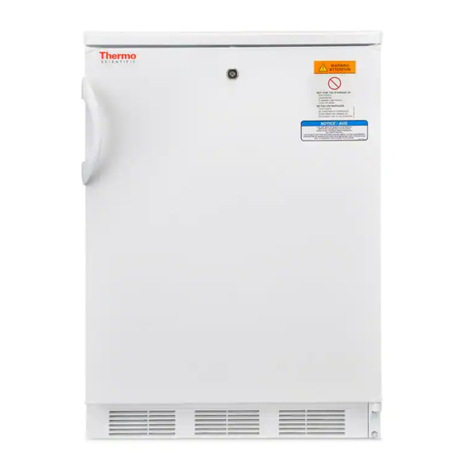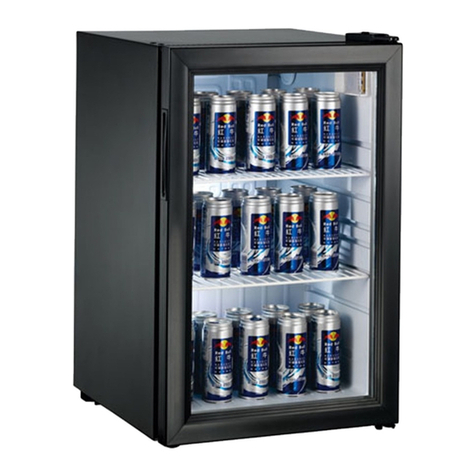Felix Storch SP6DS-2D User manual

PROBLEM POSSIBLE CAUSE WHAT TO DO
Refrigerator is not
Cooling Refrigerator in defrost
cycle Wait about 40 minutes for
defrost cycle to end
Refrigerator control in 0
(off) position Move the refrigerator and
freezer control to a tem-
perature setting.
Refrigerator is un-
plugged Push the plug completely
into the outlet
The fuse is blown/circuit
breaker is tripped Replace fuse or reset the
breaker
Vibration or rattling
(slight vibration is
normal)
Refrigerator is not rest-
ing on the feet Adjust feet
Motor operates for
long periods.
(Modern refrigerators
with more storage
space and larger
freezer require more
operating time. )
Normal when refrigerator
is first plugged in Wait 24 hours for the re-
frigerator to completely
cool down
Often occurs when large
amounts of food are
placed in refrigerator
This is normal
Temperature controls set
at the coldest setting. See Controls
Refrigerator has
odor Food transmitting odor or
refrigerator Food with strong odors
should be tightly wrapped.
Keep an open box of bak-
ing soda in the refrigera-
tor.
Interior needs cleaning See care and cleaning
Too frequent or too long
openings
Moisture collects
inside (in humid
weather, air carries
moisture into refrig-
erator when doors
are opened)
Open containers of water
or warm food in the
refrigerator
Cover or seal open con-
tainers. During a defrost
cycle, moisture will be
removes from the refrig-
erator, but may return with
long or frequent door
openings.
SUMMIT APPLIANCE Page 10
FELIX STORCH, INC
SUMMIT APPLIANCE DIVISION
ALL REFRIGERATOR
SP6DS-2D
• Two drawer All Refrigerator
• 24” wide
• Fully finished in Stainless Steel
• Accepts full Overlay Paneling
• Decorative Handles
Thank you for purchasing this appliance and for
putting your trust in our company. It’s designed
to refrigerate your fresh foods, while adding
elegance to your home or office.
Owner’s Manual and Installation Instructions
Two drawer
Refrigerator

FOR SERVICE CALL 1.718.328.8700
Page 2
Table of Contents
SAFETY INSTRUCTIONS…………………PAGE 3-4
ABOUT THE CONTROLS…………………PAGE 5
ABOUT THE DRAWERS………………… PAGE 6
CARE AND CLEANING……………………PAGE 7-8
INSTALLATION……………………………PAGE 3
INSTALLING PANELS…………………… PAGE 6
NORMAL OPERATING SOUND……… PAGE 9
TROUBLESHOOTING…………………… PAGE 10
Write the model and serial numbers here:
Model#___________________________
Serial#________________________
Find these numbers on the back of the unit.
• Expansion and contraction of
cooling coils during and after
defrost can cause a cracking or
popping sound.
WATER
SOUNDS
• The flow of refrigerant
through the freezer cooling
coils may make a gurgling
noise like boiling water.
• Water dropping on the defrost
heater can cause a sizzling,
popping or buzzing sound dur-
ing the defrost cycle.
• A water dripping noise may
occur during the defrost cycle
as ice melts from the evapora-
tor and flows into the drain
slot.
Newer refrigerators sound
different from older refrigera-
tors. Modern refrigerators
have more features and use
newer technology.
Do you hear what I hear?
These sounds are
normal
HUMM....
WHOOSH…
• The new high efficiency
compressor may run faster
and longer than your old
refrigerator and you may
hear a high-pitched hum or
pulsating sound while it is
operating.
• You may hear a whooshing
sound when the doors
close. This is due to pres-
sure equalizing within the
refrigerator.
CLICKS, POPS,
CRACKS and CHIRPS
• You may hear cracking or
popping sounds when the
refrigerator is first plugged
in. This happens as the
refrigerator cools to the
correct temperature.
• The compressor may cause
a clicking or chirping sound
when attempting to restart
NORMAL OPERATING SOUNDS
FOR SERVICE CALL 1.718.328.8700
Page 9

SUMMIT APPLIANCE Page 8
Care and Cleaning of the Refrigerator
Ice Formation on the
Inner Rear Wall
As long as the defrost water
runs to the channel and through
the opening to the drain pan on
the compressor, automatic de-
frosting of the appliance is as-
sured. In case any ice forma-
tion on the inner wall increases
to (1/8”), the ice should be
manually defrosted.
Set the thermostat knob to 0
(off) position and leave the
drawer open. Never use electric
devices for defrosting and do
not scrape the ice or frost layer
with sharp objects. After com-
pleting defrosting, turn the
knob to the desired position and
close the refrigerator drawer.
Water is Leaking from
the Refrigerator
In case the discharged water
outlet is clogged, or the defrost
water drips over the channel, or
water leaks from the refrigerator
just clean the clogged opening
with a plastic straw. Manually
defrost the increased ice layer.
See “Ice Formation on the Inner
Back Wall”.
Behind the Refrigerator
Be careful when moving the
refrigerator away from the wall.
All types of floor coverings can
be damaged; particularly
cushioned coverings and those
with embossed surfaces.
Pull the refrigerator straight out
and return it to position by
pushing it straight in. Moving
the refrigerator sideways may
result in damage to the floor
covering or refrigerator.
When pushing the refrigerator
back, make sure you don’t roll over
the power cord.
Preparing for Vacation
For long vacations or absences,
remove all of the food and un-
plug the refrigerator.
Move the refrigerator control to
the 0 (off) position and clean
the interior with a baking soda
solution of one tablespoon of
baking soda to one quart or wa-
ter.
Leave the doors open to prevent
odors.
FOR SERVICE CALL 1.718.328.8700
Page 3
IMPORTANT SAFETY INFORMATION
READ ALL INSTRUCTIONS BEFORE USING
WARNING!
These instructions are intended
for the user. They describe the
appliance and the safe way to
use it. The instructions
were prepared for vari-
ous models/types of re-
frigerators therefore you
may find descriptions of some
accessories and functions that do
not apply to your appliance
SAFETY
PRECAUTIONS
When using electrical appli-
ances, basic safety precautions
should be observed, including the
following:
• Before connecting the appli-
ance to the power supply,
leave it standing for about 2
hours. This reduces the risk
of malfunctions in the cool-
ing system caused by ship-
ping.
• This refrigerator must be
properly installed in accor-
dance with the Installation
Instructions before it is used.
• Do not allow children to
climb, stand or hang on the
drawers in the refrigerator.
They could damage the re-
frigerator and seriously in-
jure themselves.
• Do not touch the cold sur-
faces when hands are damp
or wet. Skin may stick to
these extremely cold sur-
faces.
• Do not store or use gasoline
or other flammable vapors
and liquids in the vicinity of
this or any other appliance.
• Keep fingers out of the
“pinch point” areas; clear-
ances between the drawers
and cabinet. Be careful clos-
ing doors when children are
in the area.
• Unplug the refrigerator be-
fore cleaning or making re-
pairs.
• Setting controls to the 0 (off)
position does not remove
power to the light circuit
Children entrapment and suffo-
cation are not problems of the
past. Junked or abandoned refrig-
erators are still dangerous…even
if they will sit for “just a few
days”.

SUMMIT APPLIANCE Page 4
IMPORTANT SAFETY INFORMATION
READ ALL INSTRUCTIONS BEFORE USING
Before You Throw Away
Your Old Refrigerator:
• Take off the drawers so that
children may not easily
climb inside
• For the sake of environ-
mental protection be careful
not to damage the rear wall
of the appliance (the con-
denser unit or the tubes
when moving the refrigera-
tor) or any part of the refrig-
erating system inside the
appliance.
REFRIGERANTS
All refrigeration products con-
tain refrigerants, which under
federal law must be removed
prior to product disposal.
NOTE: Contact your appliance
retailers or your local town for
information on safely and legally
disposing of old appliances.
CHOOSING THE RIGHT
PLACE
Place the appliance in a dry and regu-
larly ventilated room. Allowed ambient
temperature depends on the model
(class) of the appliance and is stated
on the rating plate of the appliance.
This appliance is class N.
CLASS AMBIENT TEMPERATURE
SN (sub-normal) from + 56ºF to + 90ºF
N (normal) from + 62ºF to + 90ºF
ST(sub-tropical) from + 64ºF to +
100ºF
T(tropical) from + 64ºF to + 120ºF
The appliance may be exposed to the
lower or higher temperature but only
for a short period of time and the
temperature should never be lower
than 41ºF. Never place the appliance
near heat emitting devices (e.g.
cooker, radiator, water heater or similar
devices) and do not expose it to direct
sunlight.
DO NOT USE AN
EXTENSION CORD
Because of potential safety haz-
ards under certain conditions, we
strongly recommend that if you
only have a two prong outlet
have it replaced by a qualified
technician with an outlet that
meets the local codes. Required
nominal voltage and frequency
are indicated on the rating plate.
The connection to the power
supply and grounding has to be
made according to the current
standards and regulations. The
appliance resists temporary volt-
age tolerance from –15 to 10%.
Your SP6DS is only for use with
110 to 120 volts and 60 cycles
(standard in USA).
FOR SERVICE CALL 1.718.328.8700
Page 7
Care and Cleaning of the Refrigerator
Cleaning the Outside
Disconnect the power supply
before cleaning the appliance.
Do not use coarse or aggressive
cleaning agents as you can dam-
age the surface .
• Clean the exterior with a
cloth dampened with soapy
water. Dry with a soft cloth
• Remove detachable drawers;
clean them with water and a
mild liquid detergent. Wash
the interior of the appliance
with lukewarm water, mix
one or two spoonfuls of vine-
gar.
• Attach the drawers once air
dried.
• Every now and then wipe the
condenser on the rear wall.
Use a soft non-metal brush
or vacuum cleaner.
The stainless steel doors and han-
dles (on some models) can be
cleaned with a commercially
available stainless steel cleaner.
Do not use appliance wax or
polish on the stainless steel.
• Do not wipe the refrigerator
with a soiled dish cloth or wet
towel. These may leave a resi-
due that can erode the paint.
• Do not use scouring pads,
powered cleaners, bleach or
cleaners containing bleach
because these products can
scratch and weaken the paint
finish.
To help prevent odors, leave an
open box of baking soda in the
fresh food and freezer compart-
ments
Automatic Defrosting of the
Refrigerator
There is no need to defrost the
refrigerator, because the ice de-
posited on the inner back wall is
automatically defrosted.
Ice deposits on the inner back
wall during compressor opera-
tion; later on, when the com-
pressor is not operating, ice de-
frost any water and drains
through the outlet in the inner
back wall into the drain pan
situated above the compressor
where it evaporates.

SUMMIT APPLIANCE Page 6
ABOUT THE DRAWERS
Removal/Replacing
Drawers
To remove the drawers from the
refrigerator the directions need
to be followed:
• Pull the drawer towards you
completely
• On both sides of the drawers
there are two hinges
• On each hinge there is a black
lever
• The left lever should be pulled
up
• The right lever should be
pulled down
• Both levers should be pulled
at the same time while con-
tinuing to pull out the drawer.
To reinstall the drawers on the
appliance:
• Just simply line up the hinges
on the drawer and the hinges
on the appliance and gently
push the drawer in.
• Once lined up close the
drawer completely then open
it up again to make sure the
drawer is on track.
Note: Please refer to the
enclosed instructions for
directions on applying
overlay panels.
It is strongly recom-
mended that you contact
a qualified technician to
assist you with any nec-
essary repairs
IMPORTANT!
It is highly suggested that
you install the Ant-Tip
Bracket before use.
Never allow children to play
or stand in the drawers!
FOR SERVICE CALL 1.718.328.8700
Page 5
About the controls
Operation Control
The refrigerator is controlled by the thermostat knob located to
the right side of the top drawer ( it can be seen when the drawer is
opened or removed).
Turn the knob clockwise from the 0 (off) to 7 (max). And back
counter clockwise to 0 (off).
Temperature Selection
• The settings of the temperature control are from 0(off) to 7
(max). Initially adjust the temperature control setting to 4
(norm), then adjust the thermostat to colder or warmer (as
needed).
• A higher setting on the knob (towards 7) means colder tem-
peratures in all compartments of the appliance. The tempera-
ture in the interior of the appliance may even drop between
35°- 45° F. Use the higher thermostat setting only when
required or recommended.
• The coolness of the refrigerator depends on how often you
open or close the drawer.
• To turn the refrigerator off you must turn the thermostat to 0
(off).
Control settings will vary based on personal preferences, usage
and operating conditions, and may require more than one adjust-
ment. Factors that affect temperature include the amount of food
in the refrigerator or freezer, the frequency of door openings and
the temperature of food when it is placed in the refrigerator.
Storing Fresh Food
• Food to be stored in the refrigerator should be properly packed
as to prevent mixing various moisture degrees and odors (in
polyethylene bags or sheets, aluminum foil, wax paper, cov-
ered containers or bottles).
• Never store any inflammable, volatile, or explosive sub-
stances.
• The interior of the drawers are stainless steel, some cleaners
are not suitable for stainless steel so read the label of any
cleaners before using. Do not use abrasive or mildly abrasive
Table of contents
Other Felix Storch Refrigerator manuals
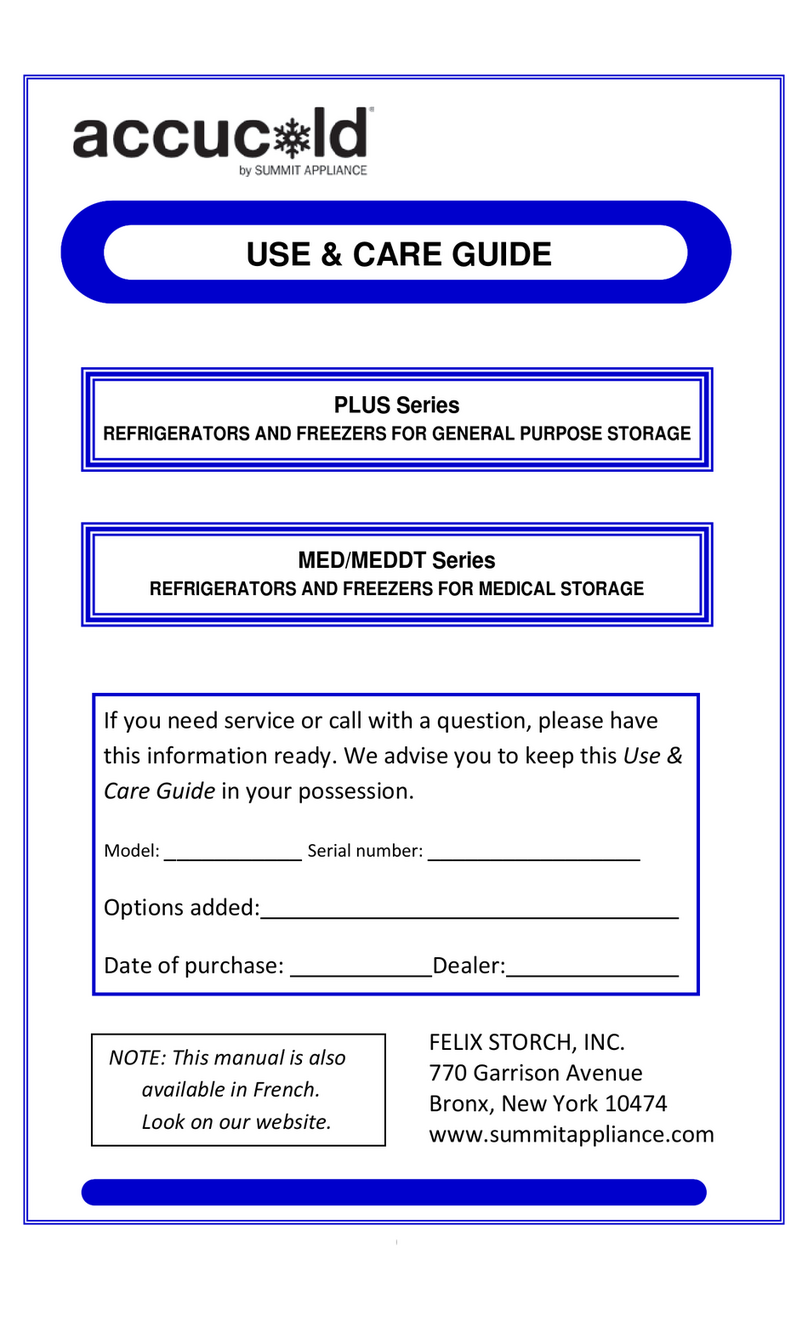
Felix Storch
Felix Storch FF6 PLUS Series User manual
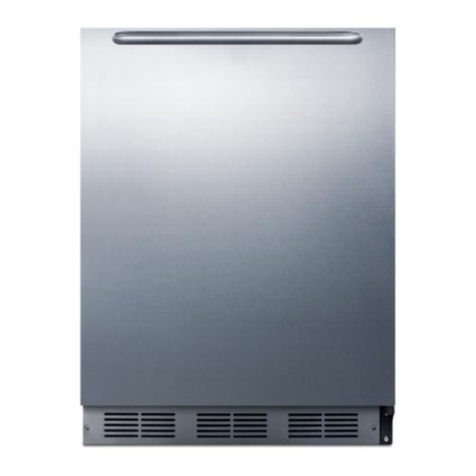
Felix Storch
Felix Storch BAR77S User manual
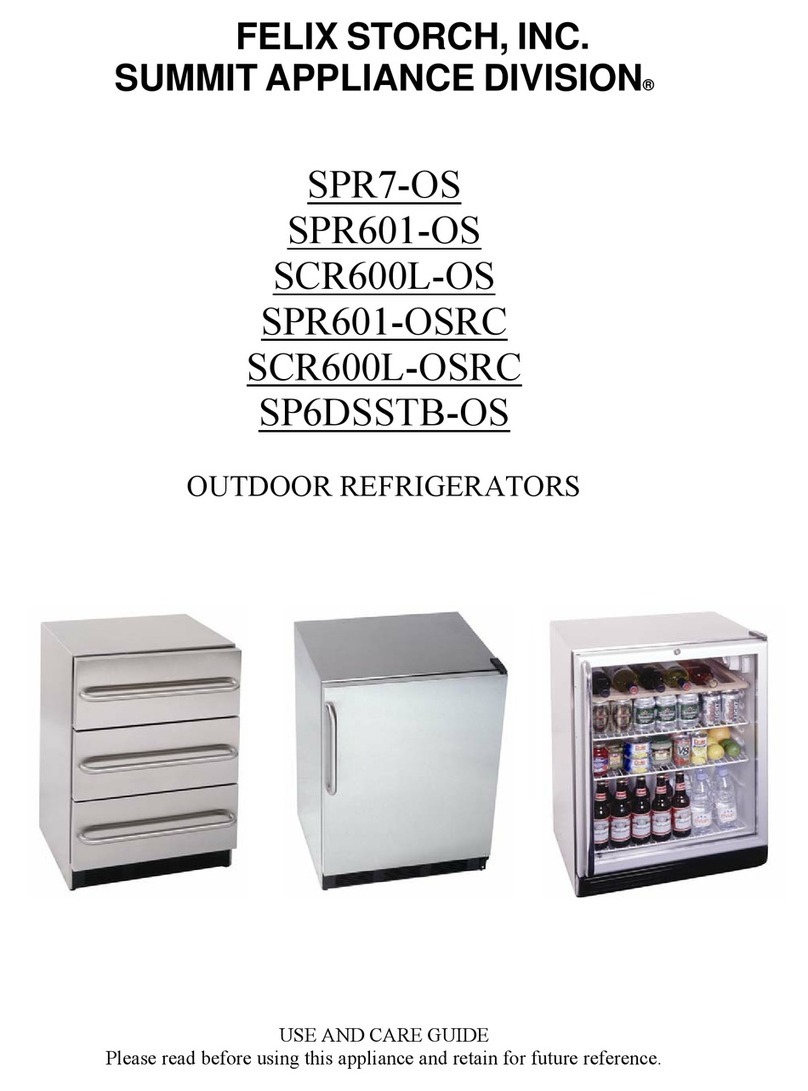
Felix Storch
Felix Storch SUMMIT SPR7-OS User manual

Felix Storch
Felix Storch Summit MBH31B Assembly instructions
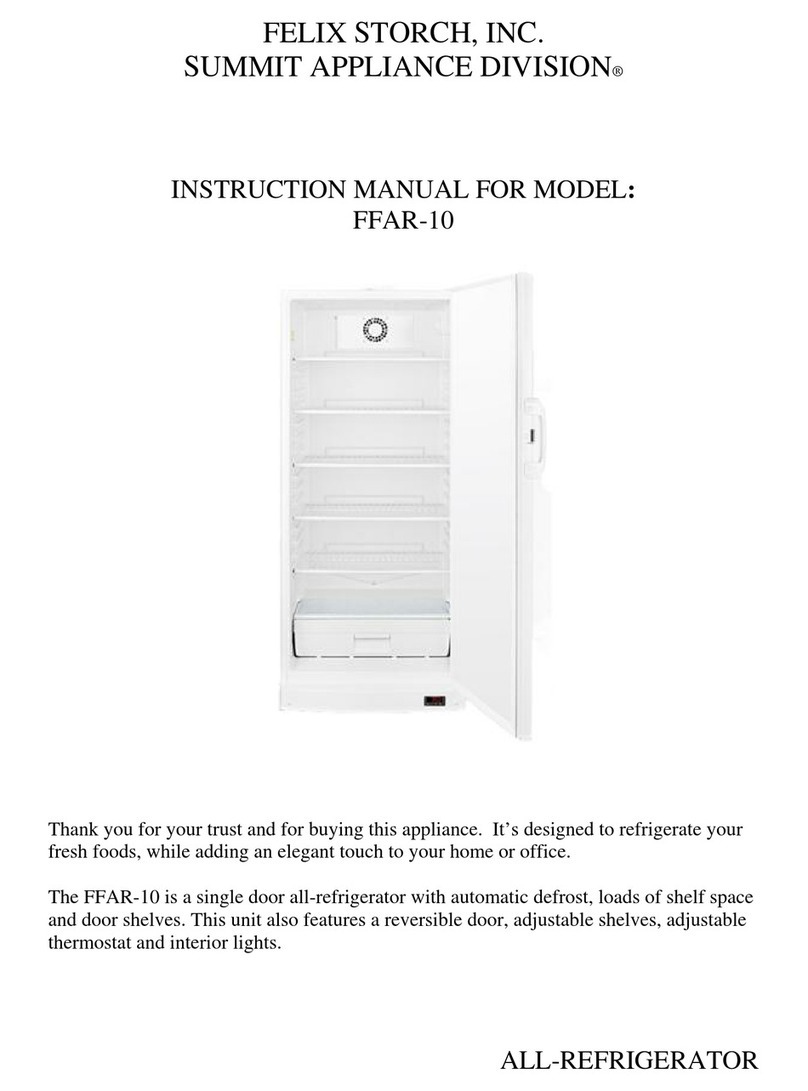
Felix Storch
Felix Storch FFAR-10 User manual
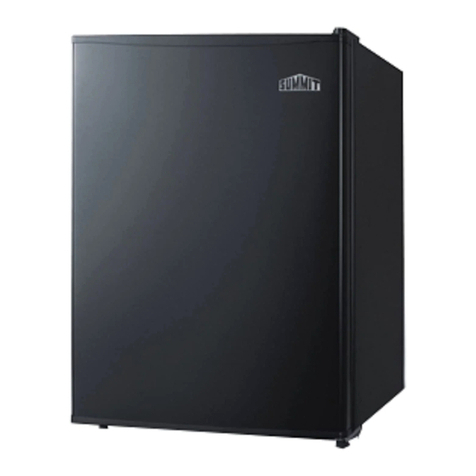
Felix Storch
Felix Storch Summit FF29K User manual
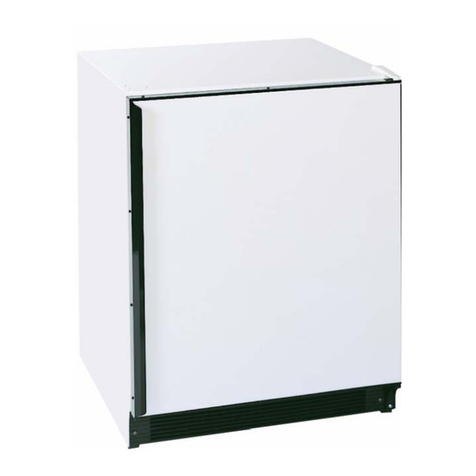
Felix Storch
Felix Storch CT-66 User manual
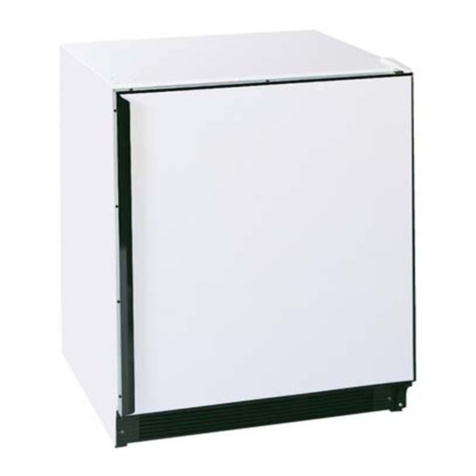
Felix Storch
Felix Storch SUMMIT APPLIANCE CT-67 User manual
